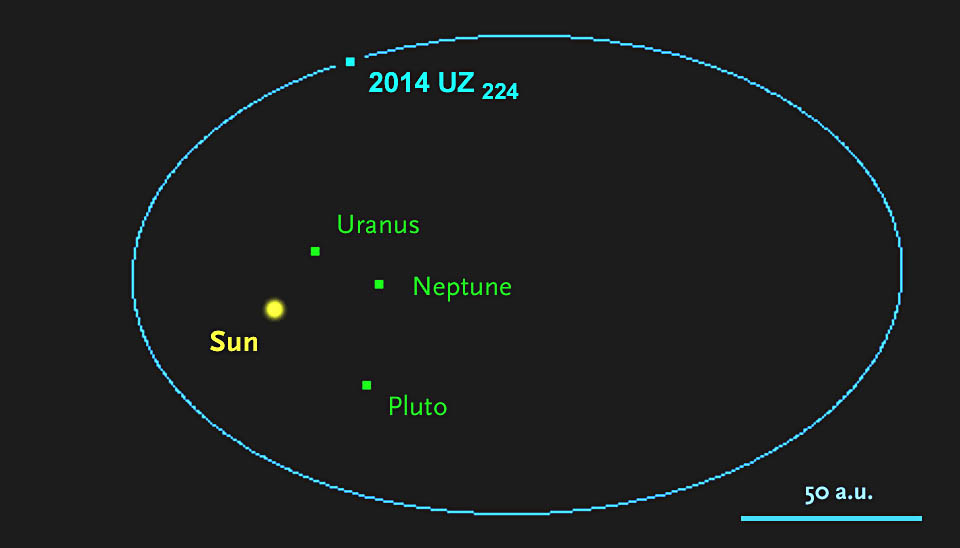Astronomy - New Object Vies for Kuiper Belt Record
Right now 2014 UZ224 lies nearly 14 billion kilometers away, ranking it third among the most distant objects known in the Kuiper Belt.
Early today the IAU's Minor Planet Center announced that astronomers in Chile have discovered a Kuiper Belt object, designated 2014 UZ224, that's currently 91.6 astronomical units from the Sun. This corresponds to 13.7 billion kilometers (8.5 billion miles), nearly three times farther out than Pluto is at the moment. Only two other known KBOs are more distant: Eris (96.2 a.u.) and V774104 (103 a.u.) to

Based on observations over the past three years, astronomers know that the Kuiper Belt object known as 2014 UZ224 has a highly elliptical, 1,140-year-long orbit that stretches nearly four times farther from the Sun than Pluto can ever be.
NASA / JPL / Horizons
NASA / JPL / Horizons
In fact, 2014 UZ224 is closer to the Sun than average right now and headed inbound. Its 1,140-year-long orbit is quite eccentric, swinging as close as 38 a.u. (think "Pluto's orbit") and as far away as 179.8 a.u. Technically, astronomers don't consider it part of the classical Kuiper Belt but instead a "scattered disk object" whose orbits have been perturbed outward due to encounters with Neptune.
A team led by David Gerdes (University of Michigan) first spotted this object in August 2014, and then several times again in 2015 and 2016, using the 4-m Victor Blanco reflector at Cerro Tololo Inter-American Observatory in Chile. Thanks to CTIO's Dark Energy Camera, which Gerdes helped develop for the Dark Energy Survey (DES), 2014 UZ224 stood out clearly in images despite its apparent magnitude of only 23½.
"The same combination of survey area and depth that makes DES a state-of-the-art cosmological survey also makes it a great tool for making discoveries in our own cosmic backyard," Gerdes explains. "Our search for trans-Neptunian objects is a serendipitous by-product of the survey data." The effort has yielded dozens of Kuiper Belt objects so far, even though the team has examined only a fraction of the amassed observations. "I hope 2014 UZ224is not the most interesting thing we eventually find!" Gerdes adds.
A pair of images from October 2014 show the motion of 2014 UZ224 (due to parallax shift) among the background stars of central Eridanus. This discovery is very faint — just 23rd magnitude.
David Gerdes / DECam
David Gerdes / DECam
For now, his team knows little more about their distant discovery other than its orbit and apparent brightness. (Gerdes has created a fact sheet about the new find.)
Given its distance, however, the object should be sizable — anywhere from 400 km across (if its surface is bright and 50% reflective) to 1,200 km (if very dark and 5% reflective). If its true size edges toward the larger end of this range, then 2014 UZ224 would likely qualify for dwarf-planet status.
Fortunately, we should have a much better estimate of the object's size very soon. Gerdes has used the ALMA radio-telescope array to measure the heat radiating from 2014 UZ224, which can be combined with the optical measurements to yield its size and albedo.
"The Blanco telescope is decades old, but DECam is a state-of-the-art instrument that has revitalized it in several ways," Gerdes explains. "First, the focal plane is huge, so the telescope now has a 3°-square field of view. And second, the DECam's CCDs are extremely sensitive in the red and near-infrared light, which makes it particularly good at detecting high-redshift objects."
. . . and apparently also good at spotting bodies at the fringes of the observable solar system.
No comments:
Post a Comment